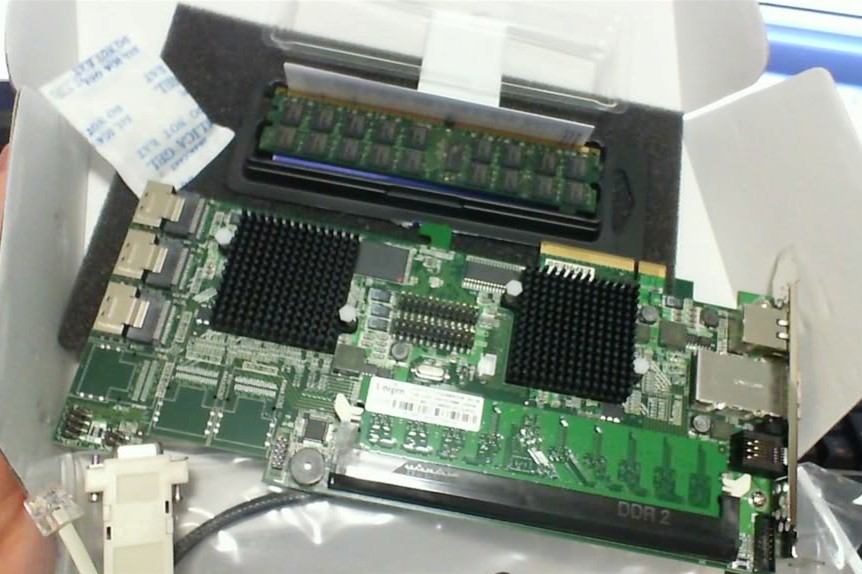Today we are testing the new Areca 1880ix-12 RAID controller. This is Areca’ premier SATA 3 internal RAID offering and signifies a great leap forward for a company known to cater to the enthusiast crowd.
With the speed and power of SSDs reinventing mainstream storage, RAID card manufacturers have been under tremendous pressure to deliver a product that can handle the massive throughput and high random reads of SSD’s combined into ultra speedy RAID arrays.
Previous generation RAID cards have been a trying venture for manufacturers as they have been unable to scale well in arrays, making the cards themselves a pointless endeavor. Ripping apart Arecas new flagship line of controllers here though, we think you will be amazed at the numbers we have pulled up for the 1880ix-12.
INTRODUCTION
We think, right off, that one of the biggest benefits of the new line of 6 Gb/s RAID cards is that they now slip into any available PCIex8 slot, thus allowing the higher throughput and sheer power for companies and enthusiasts to enjoy. Previous generation RAID cards were bottlenecked with lower speed in the PCIe bus and had slower cache. The Areca 1880 has expandable cache, which we believe to be a huge bonus that results in awesome numbers, unlike former designs that had a select amount of Ram cache that could not be altered and was limited to the user. The 1880 series (ix-12/ ix-16/ix-24) can be upgraded from the standard 1 GB cache to 2GB or even 4GB of cache.
The Areca ARC 1880 is comprised of some very easily identifiable main components that include two large black heatsinks, each of which hides the ‘brains’ behind this powerful raid card. The heatsink nearest to the PCI-e slot cools the LSI2108 ROC which is the cards CPU and allows RAID processing to occur. The performance of the card relies directly upon the power of the ROC which runs at 800 MHz. This ROC, built by LSI, is currently the fastest on the market and used by LSI and many other vendors in their RAID cards.
The PCI-e bracket holds the infiniband connector and the Ethernet connector. These allow the user to control the card from another computer and access the key functions for ease of configuration. There is also an external port for adding external drives or enclosures to the card which allows more flexibility as the enclosures can hold many many drives. Ports on the opposite end enable connection of internal drives via SAS/SATA or SAS/SAS. Each port can handle four drives. The heatsink to the right of the card cools the expander, which controls the ‘traffic’ that is coming across the ports of the card.
Last but not least, one of the absolute keys to this cards performance is the RAM slot. The Areca 1880 has upgradeable cache for a maximum of 4gb of DDR2 800, whereas previous cards were limited to 600 mhz.
As our review progresses and we get into the fun stuff, you will soon learn that cache is cash~! It really is the catalyst for some of the great performance that you will experience with this card.
SPECIFICATIONS
Adapter Architecture
- 800 MHz for raid core and sas microcode (LSI2108 ROC)
- One ddr2-800 socket with default 1GB, upgradeable to 4GB
- Supports write-thru or write-back cache
- BIOS boot support for greater fault tolerance
- Battery Backup Module Ready (optional)
Raid Features
- RAID level 0, 1, 1E, 3, 5, 6, 10, 30, 50, 60, Single Disk or JBOD
- Multiple RAID selection
- Online array roaming/offline RAID set
- Online RAID level/stripe size migration
- Online Capacity expansion and RAID level migration simultaneously
- Online volume set growth
- Instant availability and background initialization
- Up to (128) 6 Gb/s and 3 Gb/s SAS/SATA/SSD drives using 6 Gb/s SAS expanders
- Up to 6 Gb/s per port
- PCIe 2.0 X8 lane compliant
Pg 1 – Introduction
Pg2 – Test Bench & Protocol
Pg3 – Preliminaries, ATTO & Crystal DiskMark
Pg4 – AS SSD & HD Tach
Pg5 – Windows Index & HDTune Pro
Pg6 – IOMeter & Everest
Pg7 – PCMark Vantage and Conclusions
Would you like to discuss testing or see further tests conducted?
 The SSD Review The Worlds Dedicated SSD Education and Review Resource |
The SSD Review The Worlds Dedicated SSD Education and Review Resource | 


These may be great cards for enthusiast gamer workstations. We’ve had poor reliability in our IO intensive enterprise application. They crash, taking the OS with them. We’re swapping them back out, in favor of slower but reliable enterprise class controllers.
I know your comment is 2 yrs old, but what else would you recommend for extreme IO Raid controllers then?
I use to use Adaptec in the oooold days around 2001 and they were expensive and mostly crap, I managed to break at least 2 I can think of, but its been 12 yrs and I am willing to try again, if you say they dont break 🙂 How many times in how many 24-7 days did the Areca cards crash?
I know this is an old test, but how can this RAID controller fire off more than 2GB/s ?
It’s labeled as a PCI-e 8x, meaning 8 channels of 250MB/s each way, max 2 GB/s (bit less as we divide by 1024 but still).
Did they use the full 16x when they had to or is this testnumber of 3GB/s skewed by the cache on the RAID card?
Lets say you fired up 64GB RAM, used 56GB in a RAMdisk for extreme IO purposes, then took a backup of those 56GB to the RAID, could it maintain 2+ GB/s then?
Would be interesting to test out next time.